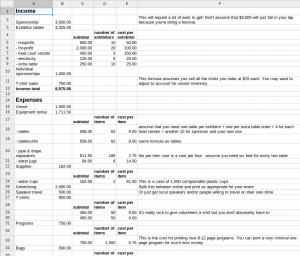
Before you get too far into planning the festival, you need a budget. It’s important to make sure that your projected expenses match your projected income, or you could find yourself in big trouble.
Check out our sample budget on Google Drive. Feel free to copy it and start editing.
If you are not already volunteering with an existing 501(c)(3), you should look for an organization willing to have you organize this event as one of their programs. You may also pursue a fiscal sponsorship arrangement as a way of doing the festival under a nonprofit umbrella. This sort of arrangement, as well as the formation of a new 501(c)(3), are well outside the scope of this guide.
This guide assumes that you are doing this work under the auspices of a 501(c)(3) nonprofit organization. You will be able to accept tax-deductible donations to fund the event, you may receive discounts for venue costs, rental equipment, and services, and you may be exempt from sales tax, depending on your state.
This budget also assumes an indoor event. Outdoor events are much more complicated and require equipment like generators, tents, etc.
Income
Income from the event primarily comes from three sources, organizational sponsorship, individual sponsors, and exhibitor fees. Running a campaign on Indiegogo or a similar crowd-funding site is an excellent way to solicit individual sponsors. Another potential income source is selling advertising in the program.
See our sponsors and exhibitors page for more details on exhibitor pricing.
Expenses
This can vary wildly depending on the venue you choose and what they provide. For the Twin Cities Veg Fest, our venue was quite affordable and the venue rental included tables, chairs, and display backing board
If you can partner with a local student group (or you are a student group), a local university may be able to provide space at a greatly discounted rate.
Spending funds on speakers can be a significant temptation, but we caution against it. Speakers that are big names outside of the animal protection movement can cost a lot of money (like $10K). And if you get a name that’s big, you’ll need more seating than the couple hundred that is suitable for local speakers. You’ll also want to promote it more, and at this point you’re coming close to organizing a separate event. We have found that inviting local speakers that we know and trust, but won’t draw lots of outside people, meets our needs.
Many of the expenses in our sample budget are optional. For example, you can elect not to provide custom-printed bags, provide fewer bags, provide plain bags, etc. You can also choose not to provide an expensive program and just print schedules on a single sheet of paper. Ultimately, you will need to adjust the budget to meet your own priorities.
Merchandise
Merchandise is not a big money maker! Don’t plan to print 500 t-shirts for an event that you expect to bring in 1,000 people. If you’re lucky, you might be able to sell one $15 t-shirt for every 20 people at your event. That means 50 shirts for 1,000 people. At 50 shirts, a sweatshop-free two-color shirt will cost you about $10 each. That means if you sell them all at $15 each you’ll make $250, if you sell them all. Realistically, you should plan to break even on merchandise, which means being conservative in how much you purchase. It’s better to sell out than end the event with a lot of inventory that is suddenly irrelevant.
